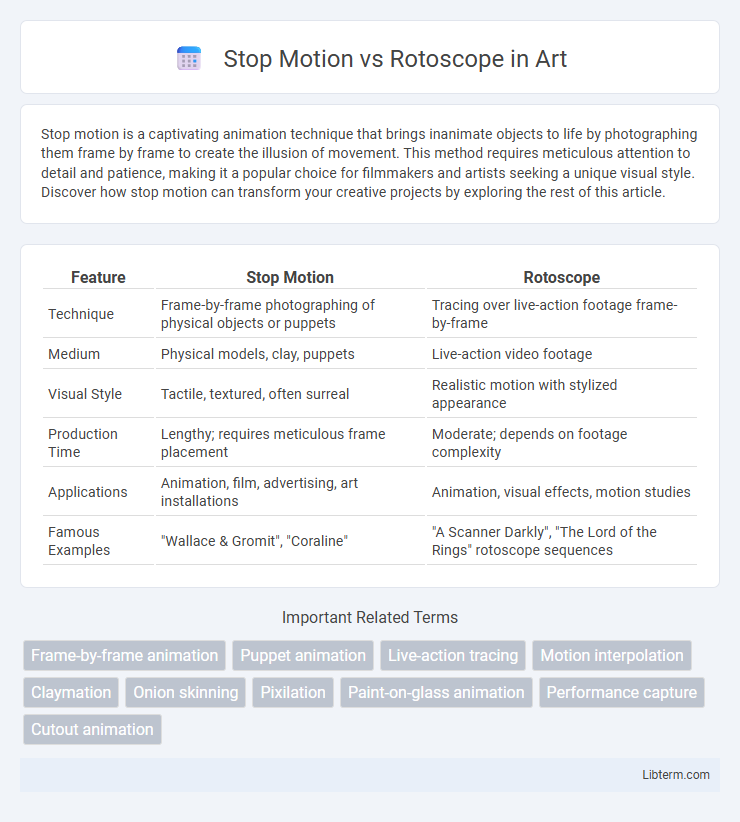Stop motion is a captivating animation technique that brings inanimate objects to life by photographing them frame by frame to create the illusion of movement. This method requires meticulous attention to detail and patience, making it a popular choice for filmmakers and artists seeking a unique visual style. Discover how stop motion can transform your creative projects by exploring the rest of this article.
Table of Comparison
| Feature | Stop Motion | Rotoscope |
|---|---|---|
| Technique | Frame-by-frame photographing of physical objects or puppets | Tracing over live-action footage frame-by-frame |
| Medium | Physical models, clay, puppets | Live-action video footage |
| Visual Style | Tactile, textured, often surreal | Realistic motion with stylized appearance |
| Production Time | Lengthy; requires meticulous frame placement | Moderate; depends on footage complexity |
| Applications | Animation, film, advertising, art installations | Animation, visual effects, motion studies |
| Famous Examples | "Wallace & Gromit", "Coraline" | "A Scanner Darkly", "The Lord of the Rings" rotoscope sequences |
Introduction to Animation Techniques
Stop motion animation involves physically manipulating objects and photographing them frame-by-frame to create movement, commonly used with puppets, clay models, or everyday items. Rotoscoping is a technique where animators trace over live-action footage to produce realistic motion, frequently employed in character animation and visual effects. Both methods offer unique advantages: stop motion delivers tactile, textured visuals, while rotoscoping provides fluid, lifelike motion.
What is Stop Motion?
Stop motion is an animation technique that involves physically manipulating objects in small increments between individually photographed frames to create the illusion of movement. It is commonly used with puppets, clay figures, or everyday items, emphasizing tactile craftsmanship and three-dimensional realism. This method contrasts with rotoscope animation, which traces over live-action footage for smoother, lifelike motion.
What is Rotoscope Animation?
Rotoscope animation is a technique where animators trace over live-action footage frame by frame to create realistic motion in animated sequences. This method enhances the fluidity and accuracy of character movements by directly referencing filmed actors or objects. Unlike stop motion, which involves capturing physical models frame by frame, rotoscoping relies on live footage as a base for detailed and lifelike animation.
History and Evolution
Stop motion animation originated in the late 19th century, with pioneers like J. Stuart Blackton and Willis O'Brien bringing inanimate objects to life through frame-by-frame photography. Rotoscoping was invented in 1915 by Max Fleischer, revolutionizing animation by tracing live-action footage to create realistic movement. Both techniques have evolved with technology, blending traditional craftsmanship with digital tools to enhance visual storytelling in film and media.
Key Differences Between Stop Motion and Rotoscope
Stop motion animation involves physically manipulating objects frame-by-frame to create movement, whereas rotoscope animation traces over live-action footage to produce realistic motion. Stop motion relies on tangible models and sets, offering a textured, handcrafted aesthetic, while rotoscoping depends on recorded video for precise character movements. Key differences include the production process, visual style, and dependence on physical objects versus filmed performances.
Creative Advantages of Stop Motion
Stop Motion animation offers unparalleled tactile creativity by allowing artists to physically manipulate objects frame-by-frame, resulting in a unique, textured aesthetic that is difficult to replicate digitally. This technique fosters innovation through hands-on interaction with materials like clay, puppets, and everyday items, enhancing storytelling with tangible depth and authenticity. The ability to experiment with lighting, shadows, and miniature sets provides Stop Motion with a distinctive artistic charm that elevates visual narratives in a way rotoscope animation cannot match.
Unique Benefits of Rotoscoping
Rotoscoping offers unparalleled precision in capturing realistic human motion by tracing over live-action footage, making it ideal for achieving lifelike animation with detailed expressions and fluid movements. It enables seamless integration of animated characters into complex live-action environments, preserving natural lighting and shadows for enhanced visual coherence. This technique also allows animators to manipulate specific elements frame-by-frame, providing creative control that is difficult to replicate with traditional stop motion methods.
Tools and Software Used
Stop motion animation relies heavily on cameras, lighting equipment, and physical models or puppets, with software like Dragonframe providing frame-by-frame capture and precise motion control. Rotoscope animation, on the other hand, uses digital video footage as a base, with tools such as Adobe After Effects, Toon Boom Harmony, and Mocha Pro enabling artists to trace and refine live-action frames for a seamless animated look. Both techniques require specialized software tailored to their unique workflows, emphasizing manual frame manipulation in stop motion versus digital tracing and compositing in rotoscope.
Famous Examples in Film and Media
Stop motion animation is exemplified by iconic films such as "The Nightmare Before Christmas" and "Coraline," which showcase intricate frame-by-frame manipulation of physical models to create lifelike motion. Rotoscoping gained fame through works like "A Scanner Darkly" and Ralph Bakshi's "Heavy Traffic," where live-action footage is traced to produce fluid, expressive animation. Both techniques have profoundly influenced visual storytelling, offering distinct aesthetic experiences that continue to shape modern film and media.
Choosing the Right Technique for Your Project
Stop motion animation creates tangible, textured visuals by physically manipulating objects frame-by-frame, ideal for projects requiring a handcrafted, tactile aesthetic. Rotoscoping overlays hand-drawn or digital animation onto live-action footage, offering precise, fluid motion that suits realistic or stylized character animations. Selecting the right technique depends on your project's desired visual style, budget constraints, and production timeline, with stop motion demanding more time for physical setups and rotoscoping requiring skilled frame-by-frame tracing.
Stop Motion Infographic

 libterm.com
libterm.com